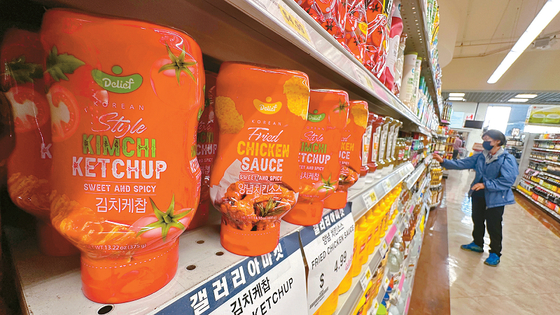Korean-made K-sauce seems to be taking over the K-food trend.
The 2023 U.S. imports data for sauces and seasonings, compiled from U.S. Customs Service trade data by Korea Agro-Fisheries & Food Trade Corporation (aT) and ImportGenius Korea, show that Korean sauce products are the eighth most imported, with nearly 20,000 tons brought in. With an average quarterly growth rate of 5%, the import of these sauce products is rapidly increasing.

Minho Kim, head of aT’s Los Angeles office, elaborates, “K-sauces encompass a variety including gochujang (red chili paste), doenjang (bean paste), soy sauce, chunjang (black bean paste), and others such as bulgogi and ribs seasoning, tteokbokki, and green onion salad marinade.” ”While exports to the U.S. were mainly led by gochujang, the value of other sauces to the U.S. in 2023 reached $35 million, the same as gochujang.”
“The popularity of K-food has led to a growing interest in Korean food among non-Korean households, and the demand for K-sauces that allow them to easily prepare Korean food is growing rapidly,” he added.
Reacting to this trend, Korean companies have introduced a range of new sauces to the market, such as Samyang Buldak Hot Sauce, Kyochon K1 Sauce, and Nongshim Chapaghetti Sauce.
Over 200 domestic buyers are responsible for importing Korean sauces and seasonings into the U.S. U.S. subsidiaries of Korean food conglomerates such as CJ Foods USA, Sampio Food Service, Nongshim America, and Pulmuone Foods USA, as well as Asian food and retail companies such as Jayone Foods, Grand BK, and Wang Globalnet, are the main importers.
Last year’s leading importer of Korean sauces and seasonings, CJ Foods USA, brought in a total of 2,310 tons. CJ leads the K-sauce market with its Haechandle brand of gochujang, doenjang, and ssamjang, as well as meat seasonings. Sampio Food Service, which focuses on soy sauce, imported a total of 2191 tons. The company has more than 20 types of soy sauce in the Americas, such as soy sauce for dumplings.
“As the variety and brands of sauce products diversify, we are expanding our store’s sauce section,” said Jongpil Hwang, manager of Galleria Market Olympic Store in LA Koreatown. He added, “Recently, Delief’s Fried Chicken sauce, Kimchi Ketchup, and Beef BBQ sauce have been well received by customers.”
The popularity of spicy sauces has also contributed to the surge in K sauce exports to the U.S. There are more than 15 types of spicy sauces sold in Korean markets, including Samyang Buldak Sauce, Chungwoo Capsaicin Sauce, Paldo Teumsae Sauce, and Isulnara Capsaicin.
Zion Market Vermont store manager John Yoon observed, “The rise in sauce sales and product diversification is influenced by the popularity of hot sauce food binges on YouTube and social media.” “In the new store, we will greatly expand our sauce section by adding Korean salad dressing, Korean pickled onion sauce, and other popular sauces from Korean restaurants,” he said.
BY EUNYOUNG LEE, HOONSIK WOO [lee.eunyoung6@koreadaily.com]




